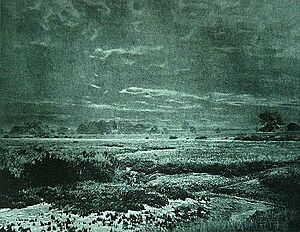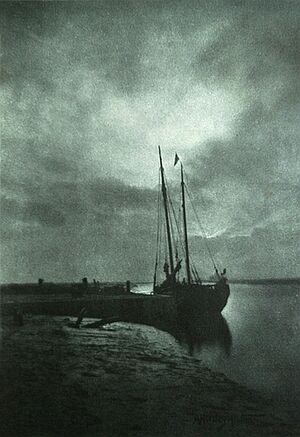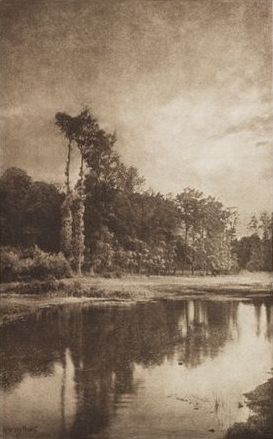Alfred Horsley Hinton facts for kids
Alfred Horsley Hinton (born in 1863 – died February 25, 1908) was a famous English landscape photographer. He was best known for his work in a style called pictorialism during the 1890s and early 1900s.
Hinton was a founding member of a group called the Linked Ring. He was also the editor of a magazine called The Amateur Photographer. He strongly supported the idea that photography could be a true art form. Hinton wrote many books about how to take great photos. His pictures were shown in art shows all over Europe and North America.
Contents
Life of a Photographer
Hinton was born in London, England, in 1863. He first went to art school because he wanted to be a painter. He became very good at painting with oils and watercolors, and at drawing.
By 1882, he found his passion: photography! In 1887, he became the editor of the Photographic Art Journal. Later, in 1893, he became the editor of The Amateur Photographer magazine. He kept this job for the rest of his life.
What is Pictorialism?
In the late 1880s, many photographers, including Hinton, believed photography should be seen as a high form of art. This idea became known as pictorialism. Hinton explained that pictorialism used "pictures of real things to create abstract ideas." This meant photographers tried to make their photos look more like paintings. They wanted to show feelings and ideas, not just exact copies of what they saw.
Hinton showed his photos at an early art show in Leeds. This show is sometimes called the first pictorialist exhibition. He also helped start the Linked Ring group in 1892. This group worked to promote photography as a fine art.
Hinton helped organize the Photographic Salon in 1893. This was an important art show for photographers. He also wrote for a French pictorialist group called the Photo Club of Paris. In 1897, a survey found that Hinton was the most popular photographer who showed his work.
Later Years and Legacy
Hinton strongly defended pictorialism. He wrote for famous newspapers like The Times and The Daily Telegraph. He was also often asked to judge photo contests.
In 1904, he helped set up the British photography exhibit at the St. Louis World's Fair in the United States. In his last years, he wrote small books to teach people basic photography skills.
In February 1908, Hinton became sick after a trip to Scotland. He passed away at his home in Woodford Green. After his death, the Royal Photographic Society held a special exhibit of his work to honor him.
Hinton's Art Style
Hinton's landscape photos often show strong foregrounds (the part of the picture closest to you) and dramatic clouds. He often took pictures in a vertical (up-and-down) format. He used special printing methods like sepia platinotype and gum bichromate. These methods gave his photos a unique look.
Unlike some other pictorialist photographers, Hinton liked his photos to be sharply focused. He sometimes changed his photos by combining clouds from one picture with a foreground from another. He even moved things around in the foreground of his subjects to make them look better! His favorite subjects were the English countryside, especially the mud flats in Essex and the Yorkshire moors.
Famous Photographs
One of Hinton's photos, "Requiem," was featured on the very first page of Alfred Stieglitz's magazine, Camera Notes, in 1897. Another photo, "Day's Decline," appeared in the same magazine two years later.
His photo "Reed Harvesting" was shown at the first London Salon in 1894. "Salt Marshes" was shown at the first Paris Salon that same year. Other well-known photos by Hinton include "Recessional" (1901), "Weeds and Rushes" (1902), "Fleeting and Far" (1903), and "The White Mill" (1907). Hinton himself said that "Melton Meadows" was his best photograph.
Many of Hinton's important photos are now part of the Royal Photographic Society collection. This collection is kept at the Victoria and Albert Museum. His photo "Fleeting Shadows" is part of the Metropolitan Museum of Art's collections.
Gallery
See also
- Constant Puyo









